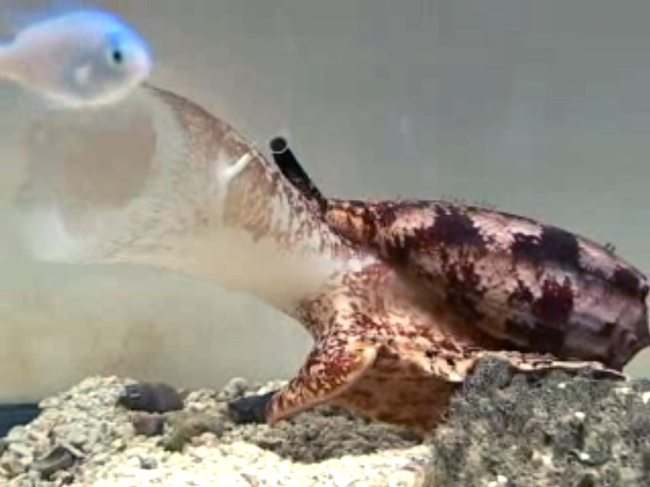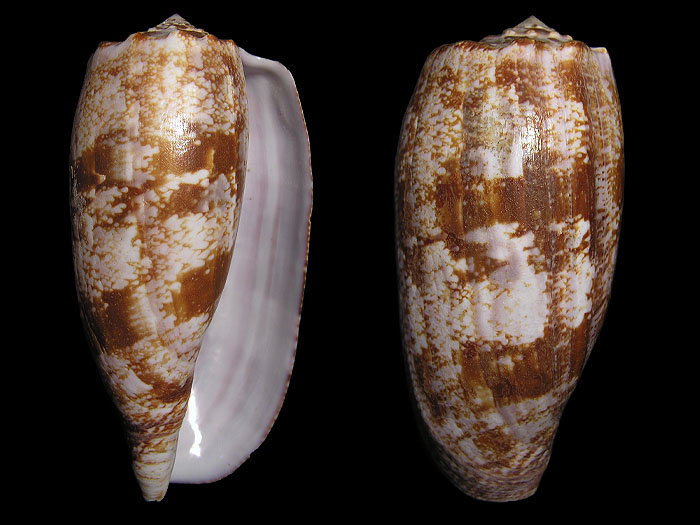Venomous Cone Snails Weaponize Insulin to Stun Prey

At least two species of cone snail have turned insulin into an underwater weapon, a new study finds. When these stealthy aquatic snails approach their prey, they release insulin, a hormone that can cause blood sugar levels to plummet.
Nearby fish don't stand a chance. The sudden influx of insulin can enter their gills and get into their bloodstream. Within moments, they don't have the energy to swim away to escape being eaten alive.
"The snail has a very large mouth, and it kind of catches the fish within the large mouth," said the study's lead researcher, Helena Safavi, a research assistant professor of biology at the University of Utah. "It's very unique that an animal has come up with a way to target metabolism in prey." [See video of a venomous cone snail eating a fish]
Safavi and her colleagues found the weaponized insulin when they were screening venoms from various cone snails. More than 100 species of these 6-inch-long (15 centimeters) underwater predators are known to release complex toxins that paralyze prey. In the past, researchers have used cone snail venom to develop medications, such as the painkiller ziconotide (brand name Prialt), a drug that is 1,000 times more potent than morphine and was designed to mimic a toxin produced by the Conus magus cone snail.
Cone snails that use small harpoons to spear their prey with neurotoxins don't use weaponized insulin. But two species, Conus geographus and Conus tulipa, use insulin in a "nirvana cabal" of toxins that they release into the water to help them disorient and snag fish, the researchers found.
"We were not actively looking for insulin," said Safavi, who was surprised by the finding.
Insulin is a hormone that helps keep blood sugar levels from getting too low or too high. People make insulin in the pancreas, but mollusks produce it in neuroendocrine cells, such as nerve cells. Unexpectedly, these two cone snail species make regular mollusk insulin in their neuroendocrine cells, and the weaponized insulin in the venom gland, the researchers said.
Get the world’s most fascinating discoveries delivered straight to your inbox.
This is the first reported case of any animal using insulin in its venom, Safavi said. What's more, the insulin resembles fish insulin, making it an effective tool against the snails' preferred prey. When the researchers injected the insulin into zebrafish, the fish became less active in less than a minute, even though the fish started the experiment with high blood sugar levels.
The weaponized insulin also varies depending on the snail's preferred diet. For instance, some cone snails that eat worms also produce insulin that is similar to worm insulin. This suggests that certain species of cone snails have honed their weaponized insulin to imitate that of their prey’s, the researchers said.
"Just as we thought there is everything to be known about insulin, somebody was able to see that you can isolate insulin to target prey,” said Frank Mari, a professor of chemistry and biochemistry at Florida Atlantic University in Boca Raton, Florida, who was not involved in the study.
The finding "is unique and novel," said Jon-Paul Bingham, an associate professor of molecular bioscience and bioengineering at the University of Hawaii, who was also not involved with the study.
It's possible that C. geographus and C. tulipa developed insulin with a similar chemical structure to fish insulin over millions of years, transforming it into an extremely selective weapon, Bingham said. Perhaps researchers can learn drug development techniques based on the cone snails' success, he added.
"A lot of drugs have side effects, and the side effects are based on being nonselective," Bingham said. "If we can attune drugs to be more selective using recipes used from cone snails, maybe, just maybe, we can build better drugs."
The fishlike insulin found in the cone snails is also the shortest insulin ever reported, which may reflect its streamlined role in decreasing blood sugar levels in prey, the researchers said. Studying the insulin's function and structure may help researchers develop new therapeutic drugs for diabetes, Safavisaid.
The findings were published Jan. 19 in the journal Proceedings of the National Academy of Sciences.
Follow Laura Geggel on Twitter @LauraGeggel. Follow Live Science @livescience, Facebook & Google+. Original article on Live Science.

Laura is the managing editor at Live Science. She also runs the archaeology section and the Life's Little Mysteries series. Her work has appeared in The New York Times, Scholastic, Popular Science and Spectrum, a site on autism research. She has won multiple awards from the Society of Professional Journalists and the Washington Newspaper Publishers Association for her reporting at a weekly newspaper near Seattle. Laura holds a bachelor's degree in English literature and psychology from Washington University in St. Louis and a master's degree in science writing from NYU.



